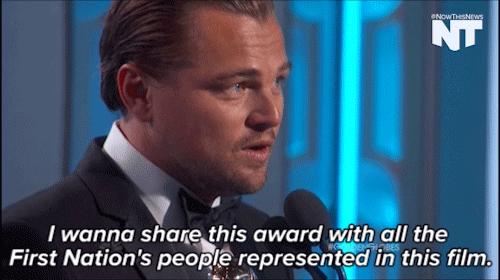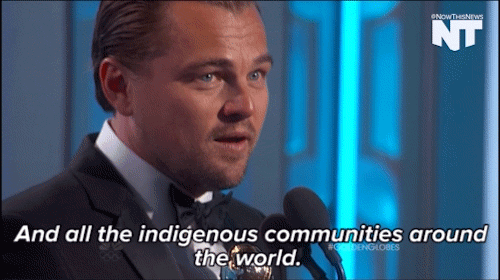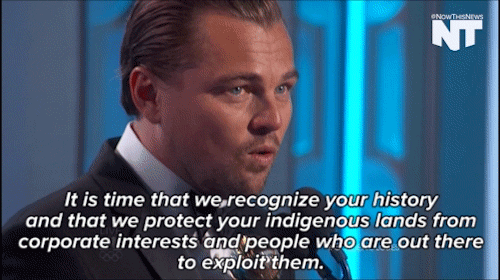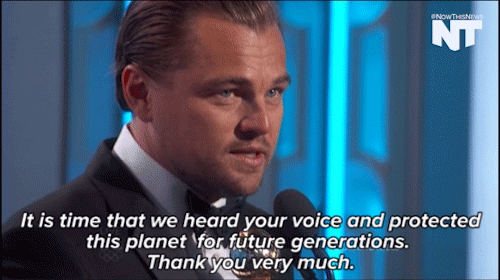// Let It Go | Swift

// let it go | Swift
More Posts from R3ds3rpent and Others




Leonardo DiCaprio accepts his award for Best Actor in a Drama Film for ‘The Revenant’ and dedicates it to indigenous communities.

What movie best represent each US state (according to subtonix)?

(Image caption: diagram of the research findings (Taken from article’s Table of Contents Image) bFGF is produced in the injured zone of the cerebral cortex. Ror2 expression is induced in some population of the astrocytes that receive the bFGF signal, restarting their proliferation by accelerating the progression of their cell cycle)
How brain tissue recovers after injury: the role of astrocytes
A research team led by Associate Professor Mitsuharu ENDO and Professor Yasuhiro MINAMI (both from the Department of Physiology and Cell Biology, Graduate School of Medicine, Kobe University) has pinpointed the mechanism underlying astrocyte-mediated restoration of brain tissue after an injury. This could lead to new treatments that encourage regeneration by limiting damage to neurons incurred by reduced blood supply or trauma. The findings were published on October 11 in the online version of GLIA.
When the brain is damaged by trauma or ischemia (restriction in blood supply), immune cells such as macrophages and lymphocytes dispose of the damaged neurons with an inflammatory response. However, an excessive inflammatory response can also harm healthy neurons.
Astrocytes are a type of glial cell*, and the most numerous cell within the human cerebral cortex. In addition to their supportive role in providing nutrients to neurons, studies have shown that they have various other functions, including the direct or active regulation of neuronal activities.
It has recently become clear that astrocytes also have an important function in the restoration of injured brain tissue. While astrocytes do not normally proliferate in healthy brains, they start to proliferate and increase their numbers around injured areas and minimize inflammation by surrounding the damaged neurons, other astrocytes, and inflammatory cells that have entered the damaged zone. Until now the mechanism that prompts astrocytes to proliferate in response to injury was unclear.
The research team focused on the fact that the astrocytes which proliferate around injured areas acquire characteristics similar to neural stem cells. The receptor tyrosine kinase Ror2, a cell surface protein, is highly expressed in neural stem cells in the developing brain. Normally the Ror2 gene is “switched off” within adult brains, but these findings showed that when the brain was injured, Ror2 was expressed in a certain population of the astrocytes around the injured area.
Ror2 is an important cell-surface protein that regulates the proliferation of neural stem cells, so the researchers proposed that Ror2 was regulating the proliferation of astrocytes around the injured areas. They tested this using model mice for which the Ror2 gene did not express in astrocytes. In these mice, the number of proliferating astrocytes after injury showed a remarkable decrease, and the density of astrocytes around the injury site was reduced. Using cultured astrocytes, the team analyzed the mechanism for activating the Ror2 gene, and ascertained that basic fibroblast growth factor (bFGF) can “switch on” Ror2 in some astrocytes.
This research showed that in injured brains, the astrocytes that show (high) expression of Ror2 induced by bFGF signal are primarily responsible for starting proliferation. bFGF is produced by different cell types, including neurons and astrocytes in the injury zone that have escaped damage. Among the astrocytes that received these bFGF signals around the injury zone, some express Ror2 and some do not. The fact that proliferating astrocytes after brain injury are reduced during aging raises the possibility that the population of astrocytes that can express Ror2 might decrease during aging, which could cause an increase in senile dementia. Researchers are aiming to clarify the mechanism that creates these different cell populations of astrocytes.
By artificially controlling the proliferation of astrocytes, in the future we can potentially minimize damage caused to neurons by brain injuries and establish a new treatment that encourages regeneration of damaged brain areas.
*Glial cell: a catch-all term for non-neuronal cells that belong to the nervous system. They support neurons in various roles.

50.1% of the US population lives in these 244 counties.
More similar maps >>

# ‘tis but a scratch | Python

Excited to start experimenting with this new #adafruit Feather Bluefruit! #arduino IDE compatible #atmega32u4 and Bluetooth LE in one tiny package! by arnie.martin @ http://ift.tt/1J3adFL

Helping Hand
Robots, video games, and a radical new approach to treating stroke patients.
BY KAREN RUSSELL
In late October, when the Apple TV was relaunched, Bandit’s Shark Showdown was among the first apps designed for the platform. The game stars a young dolphin with anime-huge eyes, who battles hammerhead sharks with bolts of ruby light. There is a thrilling realism to the undulance of the sea: each movement a player makes in its midnight-blue canyons unleashes a web of fluming consequences. Bandit’s tail is whiplash-fast, and the sharks’ shadows glide smoothly over rocks. Every shark, fish, and dolphin is rigged with an invisible skeleton, their cartoonish looks belied by the programming that drives them—coding deeply informed by the neurobiology of action. The game’s design seems suspiciously sophisticated when compared with that of apps like Candy Crush Soda Saga and Dude Perfect 2.
Bandit’s Shark Showdown’s creators, Omar Ahmad, Kat McNally, and Promit Roy, work for the Johns Hopkins School of Medicine, and made the game in conjunction with a neuroscientist and neurologist, John Krakauer, who is trying to radically change the way we approach stroke rehabilitation. Ahmad told me that their group has two ambitions: to create a successful commercial game and to build “artistic technologies to help heal John’s patients.” A sister version of the game is currently being played by stroke patients with impaired arms. Using a robotic sling, patients learn to sync the movements of their arms to the leaping, diving dolphin; that motoric empathy, Krakauer hopes, will keep patients engaged in the immersive world of the game for hours, contracting their real muscles to move the virtual dolphin.
Many scientists co-opt existing technologies, like the Nintendo Wii or the Microsoft Kinect, for research purposes. But the dolphin simulation was built in-house at Johns Hopkins, and has lived simultaneously in the commercial and the medical worlds since its inception. “We depend on user feedback to improve the game for John’s stroke patients,” Ahmad said. “This can’t work without an iterative loop between the market and the hospital.”
In December, 2010, Krakauer arrived at Johns Hopkins. His space, a few doors from the Moore Clinic, an early leader in the treatment of AIDS, had been set up in the traditional way—a wet lab, with sinks and ventilation hoods. The research done in neurology departments is, typically, benchwork: “test tubes, cells, and mice,” as one scientist described it. But Krakauer, who studies the brain mechanisms that control our arm movements, uses human subjects. “You can learn a lot about the brain without imaging it, lesioning it, or recording it,” Krakauer told me. His simple, non-invasive experiments are designed to produce new insights into how the brain learns to control the body. “We think of behavior as being the fundamental unit of study, not the brain’s circuitry. You need to study the former very carefully so that you can even begin to interpret the latter.”
Krakauer wanted to expand the scope of the lab, arguing that the study of the brain should be done in collaboration with people rarely found on a medical campus: “Pixar-grade” designers, engineers, computer programmers, and artists. Shortly after Krakauer arrived, he founded the Brain, Learning, Animation, Movement lab, or BLAM! That provocative acronym is true to the spirit of the lab, whose goal is to break down boundaries between the “ordinarily siloed worlds of art, science, and industry,” Krakauer told me. He believes in “propinquity,” the ricochet of bright minds in a constrained space. He wanted to create a kind of “neuro Bell Labs,” where different kinds of experts would unite around a shared interest in movement. Bell Labs is arguably the most successful research laboratory of all time; it has produced eight Nobel Prizes, and inventions ranging from radio astronomy to Unix and the laser. Like Bell,BLAM! would pioneer both biomedical technologies and commercial products. By developing a “self-philanthropizing ecosystem,” Krakauer believed, his lab could gain some degree of autonomy from traditionally conservative funding structures, like the National Institutes of Health.
The first problem that BLAM! has addressed as a team is stroke rehabilitation. Eight hundred thousand people in the U.S. have strokes each year; it is the No. 1 cause of long-term disability. Most cases result from clots that stop blood from flowing to part of the brain, causing tissue to die. “Picture someone standing on a hose, and the patch of grass it watered dying almost immediately,” Steve Zeiler, a neurologist and a colleague of Krakauer’s, told me. Survivors generally suffer from hemiparesis, weakness on one side of the body. We are getting better at keeping people alive, but this means that millions of Americans are now living for years in what’s called “the chronic state” of stroke: their recovery has plateaued, their insurance has often stopped covering therapy, and they are left with a moderate to severe disability.
In 2010, Krakauer received a grant from the James S. McDonnell Foundation to conduct a series of studies exploring how patients recover in the first year after a stroke. He was already well established in the worlds of motor-control and stroke research. He had discovered that a patient’s recovery was closely linked to the degree of initial impairment, a “proportional recovery rule” that had a frightening implication: if you could use early measures of impairment to make accurate predictions about a patient’s recovery three months later, what did that say about conventional physical therapy? “It doesn’t reverse the impairment,” Krakauer said.
Nick Ward, a British stroke and neurorehabilitation specialist who also works on paretic arms, told me that the current model of rehabilitative therapy for the arm is “nihilistic.” A patient lucky enough to have good insurance typically receives an hour each per day of physical, occupational, and speech therapy in the weeks following a stroke. “The movement training we are delivering is occurring at such low doses that it has no discernible impact on impairment,” Krakauer told me. “The message to patients has been: ‘Listen, your arm is really bad, your arm isn’t going to get better, we’re not going to focus on your arm,’ ” Ward said. “It’s become accepted wisdom that the arm doesn’t do well. So why bother?”
Krakauer and his team are now engaged in a clinical trial that will test a new way of delivering rehabilitation, using robotics and the video game made by Ahmad, Roy, and McNally, who make up an “arts and engineering” group within the Department of Neurology. Krakauer hopes to significantly reduce patients’ impairment, and to demonstrate that the collaborative model of BLAM! is “the way to go” for the future study and treatment of brain disease.
Reza Shadmehr, a Johns Hopkins colleague and a leader in the field of human motor-control research, told me, “He’s trying to apply things that we have developed in basic science to actually help patients. And I know that’s what you’re supposed to do, but, by God, there are very few people who really do it.”
“You bank on your reputation, in the more conventional sense, to be allowed to take these risks,” Krakauer said. “I’m cashing in my chits to do something wild.”
In 1924, Charles Sherrington, one of the founders of modern neuroscience, said, “To move things is all that mankind can do; for such the sole executant is muscle, whether in whispering a syllable or in felling a forest.” For Sherrington, a human being was a human doing.
Yet the body often seems to go about its business without us. As a result, we may be tempted to underrate the “intelligence” of the motor system. There is a deep-seated tendency in our culture, Krakauer says, to dichotomize brains and brawn, cognition and movement. But he points out that even a movement as simple as reaching for a coffee cup requires an incredibly sophisticated set of computations. “Movement is the result of decisions, and the decisions you make are reflected in movements,” Krakauer told me.
Motor skills, like Stephen Curry’s jump shot, require the acquisition and manipulation of knowledge, just like those activities we deem to be headier pursuits, such as chess and astrophysics. “Working with one’s hands is working with one’s mind,” Krakauer said, but the distinction between skill and knowledge is an ancient bias that goes back to the Greeks, for whom techne, skill, was distinct from episteme, knowledge or science.
Keep reading



The Quicksort Algorithm
Quicksort is the fastest known comparison-based sorting algorithm (on average, and for a large number of elements), requiring O(n log(n)) steps. By convention, n is the number of elements to be compared and big O is a function of those elements. Quicksort is a recursive algorithm which first partitions an array according to several rules:
Pick an element, called a pivot, from the array.
Reorder the array so that all elements with values less than the pivot come before the pivot, while all elements with values greater than the pivot come after it (equal values can go either way). After this partitioning, the pivot is in its final position. This is called the partition operation.
Recursively apply the above steps to the sub-array of elements with smaller values and separately to the sub-array of elements with greater values.
Quicksort was invented by Tony Hoare and has undergone extensive analysis and scrutiny, and is known to be about twice as fast as the next fastest sorting algorithm. In the worst case, however, quicksort is a slow n² algorithm (and for quicksort, “worst case” corresponds to already sorted). (Click this link for an example of the Quicksort Algorithm written in C)
Credit: Wolfram Alpha/Wikipedia
-
 follow-any-star liked this · 6 years ago
follow-any-star liked this · 6 years ago -
 theburgundyrabbit reblogged this · 7 years ago
theburgundyrabbit reblogged this · 7 years ago -
 shoulderfins liked this · 7 years ago
shoulderfins liked this · 7 years ago -
 volandobajobajo liked this · 7 years ago
volandobajobajo liked this · 7 years ago -
 alexandriathegreatest liked this · 7 years ago
alexandriathegreatest liked this · 7 years ago -
 thingswedonotsay liked this · 7 years ago
thingswedonotsay liked this · 7 years ago -
 paultremmel-blog liked this · 7 years ago
paultremmel-blog liked this · 7 years ago -
 syneidisi liked this · 7 years ago
syneidisi liked this · 7 years ago -
 levilllage-blog liked this · 7 years ago
levilllage-blog liked this · 7 years ago -
 milorzdev-blog liked this · 7 years ago
milorzdev-blog liked this · 7 years ago -
 valiantlywaywardeagled8-blog reblogged this · 7 years ago
valiantlywaywardeagled8-blog reblogged this · 7 years ago -
 jaisilverheart reblogged this · 8 years ago
jaisilverheart reblogged this · 8 years ago -
 gravitysnotes liked this · 8 years ago
gravitysnotes liked this · 8 years ago -
 thebestdronesfan reblogged this · 8 years ago
thebestdronesfan reblogged this · 8 years ago -
 albertrazor liked this · 8 years ago
albertrazor liked this · 8 years ago -
 bombafkl liked this · 8 years ago
bombafkl liked this · 8 years ago -
 r3ds3rpent reblogged this · 8 years ago
r3ds3rpent reblogged this · 8 years ago -
 r3ds3rpent liked this · 8 years ago
r3ds3rpent liked this · 8 years ago -
 derensposts-blog liked this · 8 years ago
derensposts-blog liked this · 8 years ago -
 thatguyamedee liked this · 8 years ago
thatguyamedee liked this · 8 years ago -
 brutexx reblogged this · 8 years ago
brutexx reblogged this · 8 years ago -
 mortallyperfectcoffee-47662-blog reblogged this · 8 years ago
mortallyperfectcoffee-47662-blog reblogged this · 8 years ago -
 mortallyperfectcoffee-47662-blog liked this · 8 years ago
mortallyperfectcoffee-47662-blog liked this · 8 years ago -
 arcadephile liked this · 8 years ago
arcadephile liked this · 8 years ago -
 puteus-blog1 liked this · 8 years ago
puteus-blog1 liked this · 8 years ago -
 niphunter liked this · 8 years ago
niphunter liked this · 8 years ago -
 thebestdronesfan liked this · 8 years ago
thebestdronesfan liked this · 8 years ago -
 nyuzaki-blog liked this · 8 years ago
nyuzaki-blog liked this · 8 years ago -
 chocomarsfreak reblogged this · 8 years ago
chocomarsfreak reblogged this · 8 years ago -
 tonynth liked this · 8 years ago
tonynth liked this · 8 years ago -
 dontworryaboutme23-blog liked this · 8 years ago
dontworryaboutme23-blog liked this · 8 years ago -
 jdjdki8d737i liked this · 8 years ago
jdjdki8d737i liked this · 8 years ago -
 atomicmorn-blog liked this · 8 years ago
atomicmorn-blog liked this · 8 years ago -
 funs-nsfw liked this · 8 years ago
funs-nsfw liked this · 8 years ago -
 xx-laurax-x-blog liked this · 8 years ago
xx-laurax-x-blog liked this · 8 years ago -
 knottychive liked this · 8 years ago
knottychive liked this · 8 years ago -
 arrevv liked this · 8 years ago
arrevv liked this · 8 years ago -
 dotspacecorepy-blog liked this · 8 years ago
dotspacecorepy-blog liked this · 8 years ago -
 prayin4dabooty reblogged this · 8 years ago
prayin4dabooty reblogged this · 8 years ago -
 blunts-and-tears reblogged this · 8 years ago
blunts-and-tears reblogged this · 8 years ago
Machine Learning, Big Data, Code, R, Python, Arduino, Electronics, robotics, Zen, Native spirituality and few other matters.
107 posts
